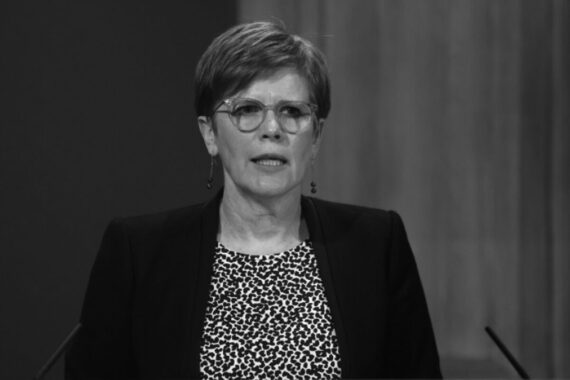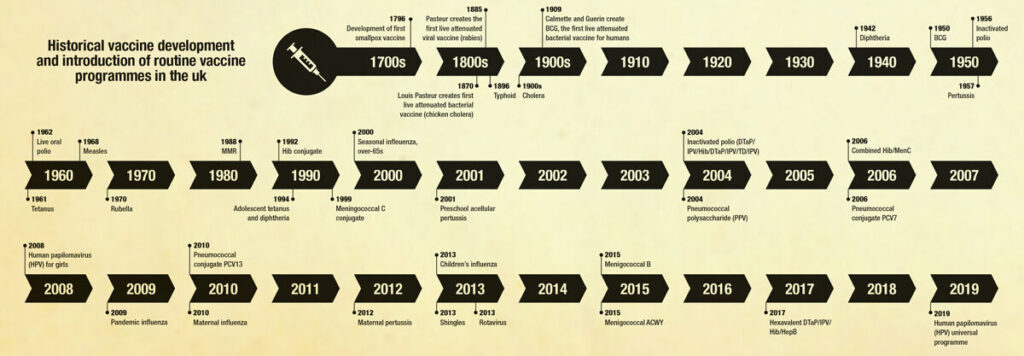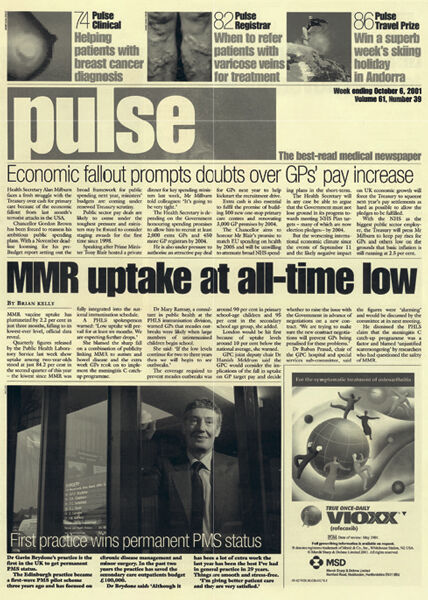Pulse in Print: How GPs helped the UK become a leader in childhood vaccinations


The second important clinical development chosen by the RCGP focuses on childhood vaccination. Dr Mary Ramsay, director of public health programmes at the UKHSA, explains why it is increasing in importance in the UK
Successful vaccination programmes are a cornerstone of public health, ranking second only to clean water as the most effective intervention for preventing disease. In the two centuries since the first scientific proof that vaccination works, millions of vaccines have been used globally successfully to prevent illness and death.
The development by Edward Jenner of the smallpox vaccine in 1796 showed the lifesaving value of vaccination, and since the creation of the NHS in 1946, the breadth and scope of the routine childhood programme in the UK has expanded.
Children born in the UK today are largely protected for life from diseases such as diphtheria, polio, measles, mumps, rubella, and group C meningitis and sepsis. Public health experts regularly respond to outbreaks and rising cases of infections with the introduction and rollout of reactive vaccination programmes, such as the response to the increase in group W meningitis in 2015. Our programmes are also protecting the very young by vaccinating pregnant women, and older people with an increasing range of vaccines for over-65s including shingles and of course Covid-19. Successful vaccination programmes against hepatitis B and human papillomavirus are now reducing the risk of two major cancer killers. And with the added benefit of ‘herd immunity’ – because vaccinated people are less likely to spread infection – the whole community is benefiting.
The numbers are impressive – we estimate that measles vaccination has prevented more than 20 million measles cases and 4,500 deaths since its introduction in 1968. In the year before the vaccine was introduced, almost 500,000 cases and 100 deaths from measles were reported in England and Wales. This vaccination programme, now with added protection against mumps and rubella, is the reason why cases have gone down. But this only occurred because the NHS has been able to reach a high proportion of children, through the efforts of doctors and nurses working in a local, accessible primary care service, free at the point of delivery.
The early digitisation of registered practice populations and of local child health information systems gave the UK a head start in being able to identify and call eligible individuals for vaccination and coordinate these programmes to achieve effective rollout and equitable coverage. This also provided the building blocks for our Covid-19 rollout, which was faster than many comparable countries.
Recently, we have made some important changes that are helping improve the effectiveness and efficiency of UK’s programmes. The successful HPV vaccination programme in schools was been updated to include young boys in 2019. Since it started in 2008, we have reduced the number of doses from three jabs to one, while sustaining high levels of protection. It was initially rolled out to girls aged 12-13 and we have already seen close to a 90% reduction in cervical cancer in these cohorts. As this was the most common cancer in women under 35, we’re confident this programme will have a lasting legacy for the whole population.

Despite immunisation being offered more widely now than ever before, a range of factors have impacted uptake of our routine programmes over the past 10 years. This gradual decline was unfortunately not helped by the pandemic. Disruption caused by Covid-19 also forced health services to prioritise emergency care and, while GPs remained open for routine immunisations during this period, we saw a drop in uptake as people followed guidance to stay at home.
As a consequence, the first infection that we expect to return now that we are all mixing again is measles. We are already seeing an outbreak in the West Midlands – in the inner-city populations in Birmingham and Coventry. We already know that in London, where coverage has been consistently lower for many years, we have a real risk of tens of thousands of cases. In 2022, we even saw poliovirus circulate in parts of London, thankfully with no cases of paralysis.
This is a wake-up call. Getting rates up to the 95% WHO target to eliminate these diseases will take sustained effort and a long-term commitment across the public health system. The UK Health Security Agency is now working to support providers to address the backlog of routine childhood immunisations across the UK.
There is much focus in the media on misinformation and vaccine hesitancy but, although we shouldn’t be complacent about this, it is not driving the long-term decline. Our annual survey of attitudes to vaccines among parents shows high confidence in NHS childhood and adolescent programmes. Parents largely trust the advice they get from GPs, practice nurses and pharmacists, and rank this as far more trustworthy than the internet and social media. In our 2022 survey, of 1,485 parents of children aged 0-5 who responded, more than 90% agreed that vaccines work and are safe.
Declining uptake is more likely a combination of some complacency about the risk of diseases with changes in people’s lifestyles and finding the time to ensure your baby or child attends their appointment. The new NHS England Vaccination Strategy aims to improve the ‘front door’ to vaccination, ensuring more flexible appointment booking systems and different vaccines are more widely available across locations, improving access and responding to each community’s needs.
Despite the recent challenges, we predict a positive future for the routine childhood programme across the UK. The most recent meeting of the JCVI advised the Government on the introduction of a universal varicella (chickenpox) vaccination as part of the childhood schedule, via a combined MMRV vaccine. In countries that already have this, rates of chickenpox are now very low.
We know most of the diseases we vaccinate against hit hardest in the most deprived communities – but this means they also stand to benefit more from effective vaccination. Improving vaccine coverage is therefore one of our most effective tools in reducing and ultimately preventing health inequalities.

‘Vaccinating their child against serious diseases is one of parents’ most important health interventions. General practice is key to the programme’s smooth running and to reassuring patients vaccines are safe, thereby making many serious diseases a rarity and saving lives.’ RCGP chair Professor Kamila Hawthorne on why the college picked childhood vaccinations as one of its major breakthroughs


‘MMR vaccine uptake was constantly in the news for public health reasons, and also since GP pay was linked to immunisation targets. GPs also reported to Pulse at the time that the refusal of then Prime Minister Tony Blair to say whether his son Leo had the jab led to more parents refusing the vaccine, showing how political the issue had become.’ Brian Kelly was clinical reporter and clinical news editor, 2001-2005
Pulse July survey
Take our July 2025 survey to potentially win £1.000 worth of tokens

Visit Pulse Reference for details on 140 symptoms, including easily searchable symptoms and categories, offering you a free platform to check symptoms and receive potential diagnoses during consultations.
Related Articles
READERS' COMMENTS [1]
Please note, only GPs are permitted to add comments to articles











And how Boris Johnson’s Government, PHE and UKHSA have since overturned all that hard work through corrupt partnership with private business with serious conflicts of interest and much misinformation !